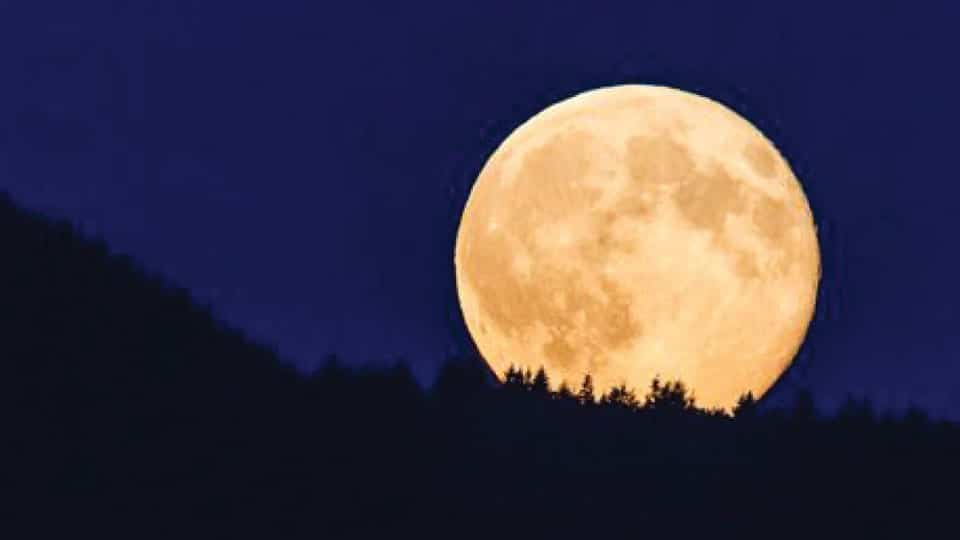By Dr. S.A. Mohan Krishna, Observational Astronomer
Coronavirus (COVID-19), lockdown, sultry weather, home stay… People are fed up of this ongoing pandemic. But now, completely deviating from COVID-19 to Astronomy, on Apr. 8, Indians are fortunate to witness the spectacular, resplendent and biggest Supermoon of this year. This is known as lunar perigee and a normal lunar perigee averaging a distance of 3,62,479 kilometres — happens once every orbital period. This event can be referred as ‘Supermoon.’
The term ‘Supermoon’ was coined by astrologer Richard Nolle. He generally describes Supermoon as perigee-syzygy — a New or Full Moon (syzygy) which occurs with the Moon at or near its closest approach to Earth (perigee) in a given orbit. In short, Earth, Moon and Sun are all in a line, with Moon in its nearest approach to Earth.
In February, Full Moon ushered in the second in a series of 4 Full Moon Supermoon occurred on Feb. 9 (3,62,479 km), Mar. 9 (357,404 km), and happening on Apr. 8 (3,57,035 km) and May 7 (3,61,181 km) and three New Moon Supermoon on Sept. 17, Oct. 16 and Nov. 15. All of these Full Moons are less than 3,63,000 km (2,25,000 miles) distant as measured from the centres of the Earth and Moon.
From extreme coastal tides to severe storms to powerful earthquakes and volcanic eruptions, the entire natural world surges and spasms under the sway of the Supermoon alignment — within three days either way of the exact syzygy, as a general rule. The geocosmic risk raised by Supermoon alignments will pass with little notice in our immediate vicinity.
The effects on Earth from a Supermoon are minor, and according to the most detailed studies by terrestrial seismologists and volcanologists, the combination of the Moon being at its closest to Earth in its orbit, and being in its ‘Full Moon’ configuration (relative to the Earth and Sun), should not affect the internal energy balance of the Earth since there are lunar tides every day. The Earth has stored a tremendous amount of internal energy within its thin outer shell or crust, and the small differences in the tidal forces exerted by the Moon (and Sun) are not enough to fundamentally overcome the much larger forces within the planet due to convection and other aspects of the internal energy balance that drives plate tectonics.
The ‘Super’ in Supermoon is really just the appearance of being closer, but unless we measure the Earth-Moon distance by laser range-finders, the LRO [Lunar Reconnaissance Orbiter] spacecraft in low lunar orbit and to watch the Earth-Moon distance over years, there is really no difference. The Supermoon really attests to the wonderful new wealth of data NASA’s LRO mission has returned for the Moon.
Astronomers have estimated that, the Supermoon will be around 15 percent brighter and 30 percent bigger than the average Full Moon. Full Moons from the way we see it, vary in size because of the oval orbit of the Moon. It is an ellipse with one side (perigee) about 50,000 km closer to Earth than the other (apogee).Experts say the short distance difference isn’t enough to cause any earthquakes or tidal effects. Although, the Earth’s tides are expected to be particularly high and low when the Moon comes closest to our planet which is known as perigean tides. That’s when the Moon exerts about 42 percent more tidal force than it will during its next cycle two weeks later. In most places, lunar gravity at perigee pulls tide waters an inch or so higher than the usual tide.
To view this weekend’s Supermoon to best effect, look for it just after it rises or before it sets, when it is close to the horizon. There, you can catch a view of the Moon behind buildings or trees, an effect which produces an optical illusion, making the Moon seem even larger than it really is. We are even privileged to see this spectacle on May 7 of 2020.
But if we need to witness the similar type of Supermoon with almost the same distance, we may have to wait till 2026. So, on Apr. 8, everyone be curious to witness this exiting astronomical spectacle and spread the grandeur and essence of Astronomy.








Recent Comments